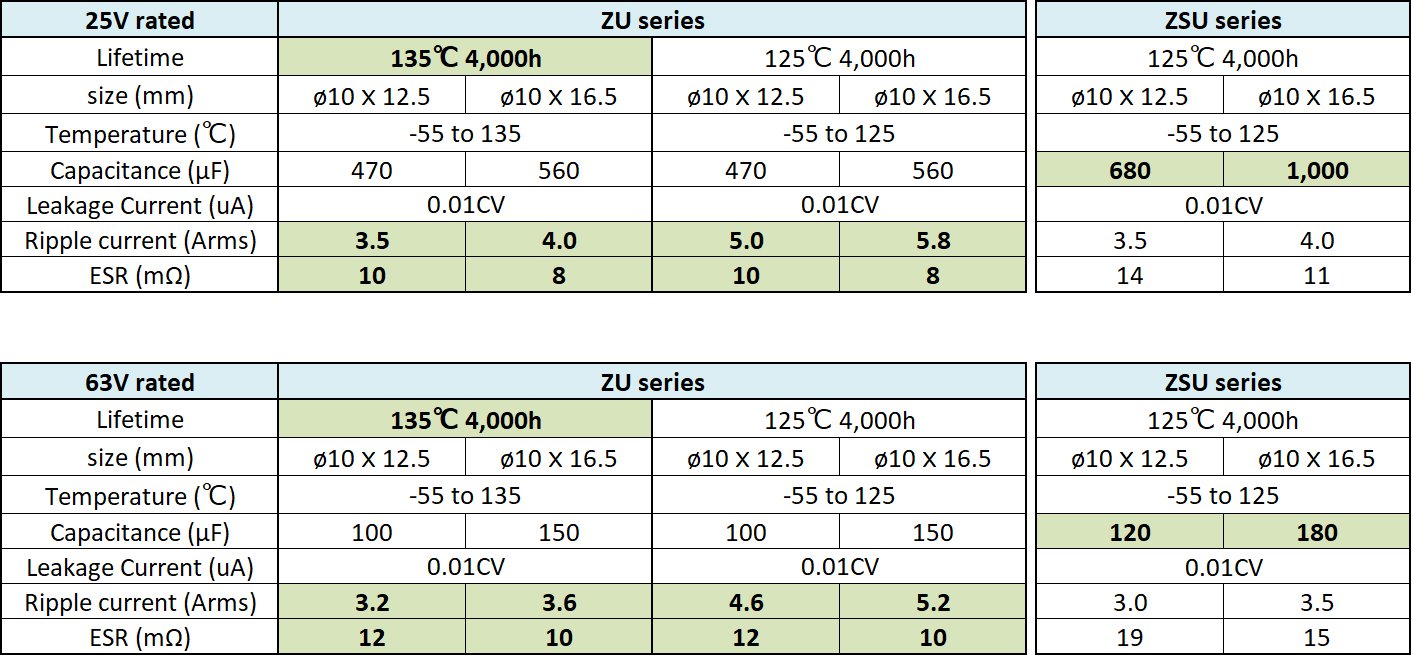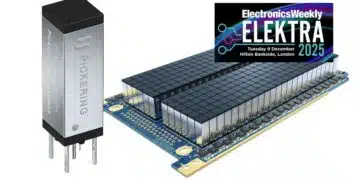Panasonic Corporation announced today that its Industrial Solutions Company has commercialized new conductive polymer hybrid aluminum electrolytic capacitors, the large-current ZU series, and large-capacitance ZSU series for use in automotive ECUs (electronic control units) [1].
Mass production will start in December 2020. The new ZU series has achieved ripple current*1 of over 1.4 times as large as the conventional ZS series (ϕ10 x 12.5 mm and ϕ10 x 16.5 mm), supporting increases in circuit load current due to high performance automotive ECUs and contributing to smaller automotive ECUs through a reduction in the number of required capacitors.
*1: As conductive polymer hybrid aluminum electrolytic capacitors of the same size as of November 10, 2020 (according to research by Panasonic)
Conductive polymer hybrid aluminum electrolytic capacitors feature low resistance and high reliability with a fusion of conductive polymer and electrolyte and are used in a wide range of applications, from control circuits in automotive engine ECUs, BMSs (battery management systems) [2], to motor drive circuits in 48 V system ISGs (integrated starter generators) [3], electric pumps, radiator fans, and further to ADAS applications (such as cameras, sensors, and control circuits). The progress in electrification and self-driving technology has led to the higher performance of automotive ECUs, which have increased circuit load currents.
The progress has also led to the implementation of redundant design [4] aiming to improve safety and reliability, resulting in use of increased number of automotive ECUs by mounting two sets of circuits in the same ECU, for example. Reducing board size is necessary for smaller mounting space, requiring cutting the number and size of capacitors by increased current and capacitance. To meet these requirements, Panasonic has commercialized the ZU series conductive polymer hybrid aluminum electrolytic capacitors with the industry’s largest ripple current by using high conductivity polymer formation technology and in-capacitor low resistance technology.
ZU series conductive polymer hybrid aluminum electrolytic capacitors features:
- The industry’s largest ripple current supports increases in circuit load current and saves board space.The ZU series has achieved ripple current of over 1.4 times as large as the conventional ZS series.
- Same capacitance value as conventional hybrid capacitors. The series has achieved large capacitance equivalent to the ZS series.
- Support high-temperature environments, guaranteed up to 135ºCThe series offers a guaranteed life of up to 4000 hours at 135ºC in addition to the 4000 hour, 125ºC guarantee for the conventional ZS series products.
Applications
- Current noise reduction and voltage stabilization in motor drive circuits (DC-link capacitors)
・ 48 V system ISGs of mild hybrid cars
・ Motor drive applications mounted on xEVs (oil pumps, water pumps, electric power steering, electric compressors, etc.) - High output DC/DC power supply (input filter capacitors, output smoothing capacitors)
Product Features
- The industry’s largest currents support increases in circuit load current and save board space.The capacitors have achieved the higher conductivity of electrolytes through the use of Panasonic’s unique conductive polymer formation technology, as well as lowering resistances inside the capacitors through the recent technology of low-resistance lead wires. This has achieved ripple current of over 1.4 times as large as the conventional ZS series, enabling a reduction in the number of required capacitors, from the use of several capacitors in parallel, as well as a reduction in the size of capacitors with the same rating, thereby contributing to board area reduction and application downsizing.
- Same capacitance value and reliability as conventional conductive polymer hybrid aluminum electrolytic capacitors. The ZU series has achieved large capacitance equivalent to the ZS series of conventional conductive polymer hybrid aluminum electrolytic capacitors by applying the same design of large-capacity and high-reliability.
- Support high-temperature environments, guaranteed up to 135ºCBy further improving the heat resistance reliability of materials based on the design that enabled the 125ºC, 4000 hour guarantee for the conventional ZS series products, the ZU series has achieved the 135ºC, 4000 hour guarantee.
Panasonic also commercializes the ZSU series conductive polymer hybrid aluminum electrolytic capacitors with the industry’s largest capacitance*2
By adopting large-capacitance anode and cathode foils, the ZSU series has achieved 1.2 to 1.8 times as large capacitance value as the conventional ZS series products. Mass production will be launched in December 2020.
*2: As conductive polymer hybrid aluminum electrolytic capacitors of the same size as of November 10, 2020 (according to research by Panasonic)
Basic specifications

Term Descriptions
[1] Automotive ECU (Electronic Control Unit)
Unit for electronically controlling systems in a vehicle.
[2] BMS (Battery Management System)
System for controlling the charge/discharge of lithium-ion batteries in xEV.
[3] 48 V system ISG (Integrated Starter Generator)
Generator that also has functions as a starter mounted in mild hybrid vehicles.
[4] Redundant design
Progress in automatic driving requires safety designs. Redundant design enables normal operation to continue, even if one circuit fails, by using another circuit.
































